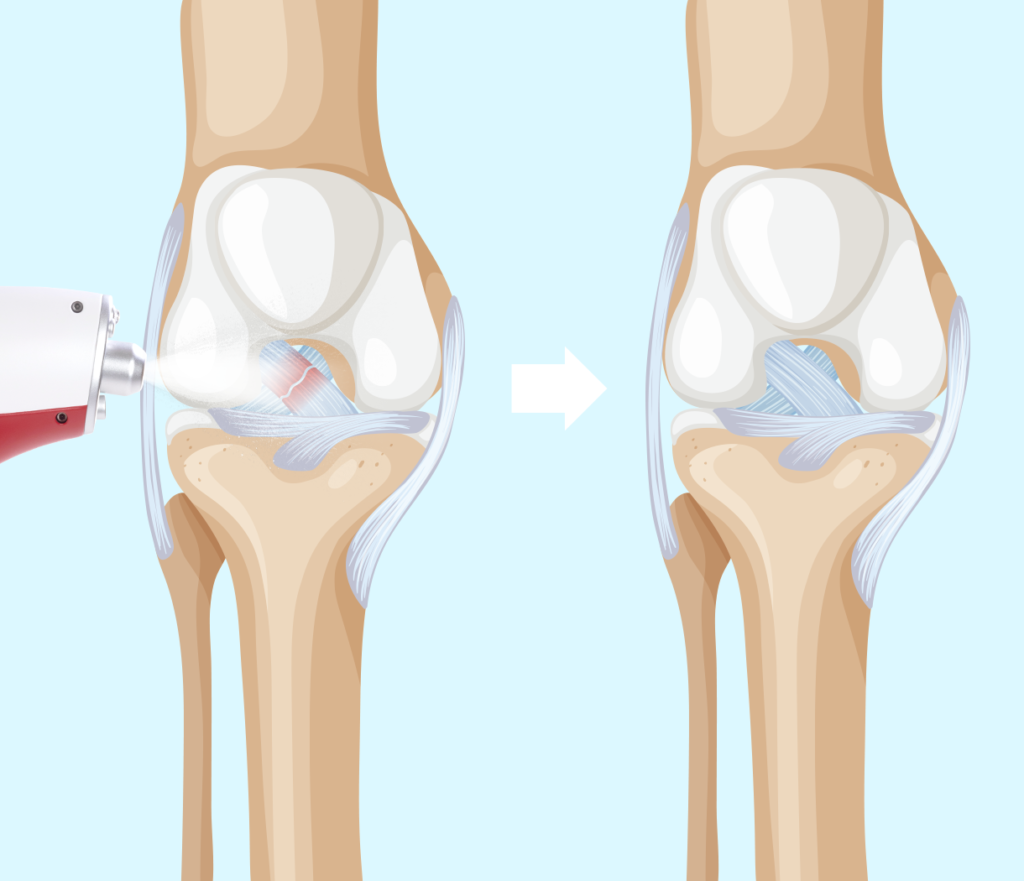소개: 재활에서 CO₂ 냉동 요법이란 무엇인가요?
진화하는 현대 의료 환경 속에서 혁신적인 치료 방식은 재활 치료법을 계속해서 변화시키고 있습니다. 이러한 최첨단 치료법 중 CO₂ 냉동 요법은 정밀성, 안전성, 치료적 냉기 적용의 효능을 결합한 혁신적인 접근법으로 부상하고 있습니다. 이 첨단 기술은 기존의 냉각 방법에 비해 크게 발전한 것으로, 의료 전문가와 환자에게 통증 관리, 염증 감소, 빠른 회복을 위한 보다 통제되고 표적화된 솔루션을 제공합니다.
CO₂ 냉동 요법의 간단한 정의
CO₂ 냉동 요법은 가압 이산화탄소 가스를 사용하여 부상 또는 염증 조직에 정밀하게 제어된 국소 냉각을 전달합니다. 이 기술은 가압 이산화탄소를 사용하여 -78°C(-108°F)의 온도에 도달할 수 있는 제어된 국소 냉각을 단기간 동안 제공합니다. 이 과정은 특수 어플리케이터를 통해 압축된 이산화탄소를 방출하는 것으로, 피부 표면에 닿으면 빠르게 팽창하고 냉각되어 치료용 저체온 상태를 조성합니다. 기존의 얼음 팩이나 냉각 시스템과는 다릅니다, CO₂ 냉동 요법 는 균일한 온도 분포, 즉각적인 시작, 정밀한 지속 시간 제어 기능을 제공하여 재활 환경에 이상적인 선택입니다.
현대 재활에서 냉찜질 요법이 필수적인 이유
냉동 요법이 현대 재활 프로토콜에 통합된 것은 냉동 요법의 치료 효과를 뒷받침하는 과학적 증거가 늘어나고 있음을 반영합니다. 냉동 요법은 수술 후 통증을 효과적으로 완화하고, 출혈을 줄이며, ROM을 개선하여 TKA 환자의 수술 후 재활을 촉진함으로써 다양한 재활 상황에서 임상적 가치를 입증할 수 있습니다. 현대 의료는 부작용을 최소화하면서 치료 효과를 극대화하는 증거 기반의 비약물적 개입을 요구합니다. 저온 요법은 약물 없이 통증을 완화하고 조직 치유를 촉진하며 기능 회복을 개선함으로써 이러한 요구 사항을 해결합니다. CO₂ 냉동 요법의 정밀성과 일관성은 치료 표준화와 재현 가능한 결과가 가장 중요한 현대 재활 환경에서 특히 유용합니다.
CO₂ 냉동 요법이 신체에서 작동하는 방식
CO₂ 냉동 요법의 근본이 되는 생리적 메커니즘을 이해하는 것은 치료 잠재력과 임상 적용을 평가하는 데 필수적입니다. 제어된 저온 노출에 대한 신체의 반응에는 통증 완화, 염증 감소 및 치유 증진에 종합적으로 기여하는 복잡한 신경생리학적, 혈관 및 세포 과정이 포함됩니다. 이러한 메커니즘은 국소 조직 반응과 전신 생리적 적응 모두에 영향을 미치는 상호 연결된 경로를 통해 작동합니다.
냉각 및 혈관 운동 반응의 과학
CO₂ 냉동 요법을 적용하면 체온 조절 메커니즘을 통해 즉각적인 혈관 운동 반응을 유발합니다. 초기 혈관 수축은 치료 부위로의 혈류를 감소시켜 염증 매개체 전달과 세포 대사 요구를 최소화합니다. 고압에서 -108°F(-78°C)의 CO₂ 가스를 방출하면 30초 이내에 피부 표면 온도를 약 39.2°F(4°C)로 빠르게 낮춥니다. 치료 중단 후에는 반응성 충혈이 발생하여 영양분 전달과 대사 노폐물 제거가 향상됩니다. 이러한 2상 혈관 반응은 조직 치유 상태를 최적화하는 동시에 지속적인 치료 효과를 제공합니다.
통증 및 염증 감소
CO₂ 냉동 요법은 여러 메커니즘을 통해 통각 경로를 효과적으로 조절합니다. 저온 노출은 신경 전도 속도를 감소시켜 중추 신경계로의 통증 신호 전달을 방해합니다. 또한 냉동 요법은 효소 활성과 염증 매개체 방출을 감소시켜 염증성 캐스케이드 활성화를 억제합니다. 영하 78°C의 CO2 냉동 요법은 염증의 핵심을 표적으로 삼아 단 몇 분 만에 부기를 줄이고 통증을 완화합니다. 통증의 게이트 제어 이론은 차가운 자극이 어떻게 통증 신호와 경쟁하여 즉각적인 진통 효과를 제공하여 치료 운동과 기능 활동을 촉진하는지를 설명합니다.
근육 회복 및 치유에 미치는 영향
CO₂ 냉동 요법으로 인한 치료적 저온 노출은 근육 회복 과정과 조직 재생에 큰 영향을 미칩니다. 제어된 저체온증은 혈류가 손상된 기간 동안 대사 요구를 제한하여 이차적인 조직 손상을 줄입니다. 이러한 보호 효과는 조직 생존력이 손상될 수 있는 외상성 부상이나 수술 후 특히 유용합니다. 이러한 냉 충격은 운동으로 인한 스트레스나 부상으로부터 근육과 관절이 더 빨리 회복하는 데 도움이 됩니다. CO2의 빠른 냉각 작용은 근육통을 줄이는 데 도움을 주며 스포츠 의학 및 재활 환경에서 그 효과를 입증했습니다.
안전 메커니즘: CO₂가 제어되고 목표가 되는 이유
이산화탄소를 냉각 매체로 사용하면 다른 극저온 물질에 비해 고유한 안전상의 이점이 있습니다. 이산화탄소는 인체에서 자연적으로 발생하므로 조직 독성이나 전신 반응에 대한 우려가 없습니다. 제어된 압력 전달 시스템은 일반적으로 치료 부위당 10~15초의 미리 정해진 노출 시간으로 일관된 온도 적용을 보장합니다. 이러한 정밀성은 과도한 조직 냉각을 방지하고 동상이나 신경 손상과 같은 저온 관련 부상의 위험을 최소화합니다. 또한 CO₂는 적용 후 주변 온도로 빠르게 따뜻해지기 때문에 장시간 추위에 노출될 위험이 줄어듭니다.
재활에서 CO₂ 냉동 요법의 주요 이점
CO₂ 냉동 요법의 치료적 장점은 기존의 냉각 방법을 넘어 재활 과정의 여러 측면을 다루는 포괄적인 이점을 제공합니다. 이러한 이점에는 즉각적인 증상 완화, 생리적 치유 강화, 환자 순응도 향상, 우수한 치료 결과 등이 포함됩니다. 이러한 다각적인 장점으로 인해 CO₂ 냉동 요법은 종합적인 재활 프로그램에서 매우 중요한 도구가 되었습니다.
더 빠른 통증 완화
CO₂ 냉동 요법은 즉각적인 신경 경로 변조를 통해 빠른 진통 효과를 제공합니다. 정밀한 온도 제어와 균일한 냉각 분포로 치료 부위 전체에 걸쳐 일관된 통증 완화를 보장합니다. 환자는 일반적으로 치료 적용 후 몇 분 이내에 상당한 통증 감소를 경험하여 조기에 거동이 가능해지고 치료 운동에 참여할 수 있습니다. 이러한 즉각적인 통증 완화 효과는 특히 급성 부상 관리 및 수술 후 관리에서 유용하며, 신속한 증상 조절은 최적의 회복 궤도를 촉진하고 만성 통증 패턴의 발생을 예방합니다.
부기 및 염증 감소
CO₂ 냉동 요법의 항염증 효과는 혈관 수축으로 인한 혈관 투과성 감소와 염증 매개체 축적으로 인해 발생합니다. TKA 후 주기적 냉동 요법은 AKSS, VAS, 허벅지 부종, ROM, PLOS 및 재활 촉진 측면에서 단기적으로 이점이 있었으며 부종 감소에서 측정 가능한 개선이 입증되었습니다. 제어된 냉기 노출은 부종 형성을 제한하는 동시에 림프 배수를 촉진하여 치료 후 몇 시간 내에 부종이 눈에 띄게 감소합니다. 이러한 항염증 작용은 반복적인 적용을 통해 지속되어 조직 치유와 기능 회복을 지원하는 누적 효과를 제공합니다.
빠른 치유 및 회복
CO₂ 냉동 요법은 최적화된 세포 대사와 개선된 순환 패턴을 통해 조직 치유를 향상시킵니다. 치료용 저온 노출은 조직 회복 과정의 필수 구성 요소인 성장 인자 방출과 콜라겐 합성을 자극합니다. 또한 염증 반응의 감소는 2차 조직 손상을 방지하여 건강한 조직 무결성을 보존합니다. 새로운 컴퓨터 제어 냉각 치료 기기는 염증 반응 감소로 인해 발생할 수 있는 수술 후 조기 가동 범위 및 통증 측면에서 이점을 제공하여 회복 일정을 앞당기는 데 중요한 역할을 하는 것으로 확인되었습니다.
향상된 이동성 및 기능
통증 완화, 염증 감소, 조직 치유 개선의 조합은 기능적 결과의 향상으로 직접 이어집니다. CO₂ 냉동 요법으로 치료받은 환자들은 기존의 냉각 요법에 비해 운동 범위가 개선되고 근력이 증가하며 운동의 질이 향상되는 것으로 나타났습니다. 즉각적인 진통 효과로 인해 치료 운동을 더 일찍 시작할 수 있어 근육 위축과 관절 경직을 예방할 수 있습니다. 이렇게 향상된 이동성은 정상적인 운동 패턴을 촉진하고 2차 부상이나 만성 기능 장애로 이어질 수 있는 보상 메커니즘의 위험을 줄여줍니다.
향상된 편의성 및 규정 준수
CO₂ 냉동 요법의 정밀한 제어와 짧은 적용 시간은 치료 중 환자의 편안함을 크게 향상시킵니다. 불편함과 피부 자극을 유발할 수 있는 장시간의 얼음 적용과 달리 CO₂ 치료는 짧고 내약성이 좋으며 잔류 수분을 남기지 않습니다. 통증 완화의 즉각적인 시작은 환자가 치료 프로토콜을 준수하도록 장려하는 긍정적인 힘을 제공합니다. 일관된 치료 적용은 냉동 요법의 누적 효과를 극대화하는 데 필수적이므로 이러한 개선된 순응도는 최적의 치료 결과를 달성하는 데 매우 중요합니다.
비침습적이고 약물을 사용하지 않는 회복 옵션
CO₂ 냉동 요법은 통증 관리 및 재활을 위한 완전히 비침습적인 약물 없는 대안을 제공합니다. 이 접근 방식은 약물 부작용, 약물 상호 작용 및 의존성 문제에 대한 우려를 없애는 동시에 효과적인 치료 결과를 제공합니다. 약물의 개입이 없기 때문에 CO₂ 냉동 요법은 진통제에 대한 금기 사항이 있거나 자연 치유 방법을 찾는 환자에게 적합합니다. 또한 이러한 비침습적 특성으로 인해 치료 복잡성이 줄어들고 간섭이나 합병증 없이 다른 치료 방식과 통합할 수 있습니다.
재활에서 CO₂ 냉동 요법의 적용
CO₂ 냉동 요법의 다용도성 덕분에 급성 스포츠 부상부터 만성 통증 질환 및 수술 후 회복에 이르기까지 다양한 재활 상황에 적용할 수 있습니다. 각 적용 상황에는 정밀하고 제어된 냉각 전달을 통해 CO₂ 냉동 요법으로 해결할 수 있는 고유한 과제와 치료 목표가 있습니다. 이러한 특정 응용 분야를 이해하면 의료진이 치료 프로토콜을 최적화하고 다양한 임상 시나리오에서 우수한 환자 치료 결과를 달성하는 데 도움이 됩니다.
스포츠 부상(염좌, 긴장, 근육 파열)
스포츠 의학에서 CO₂ 냉동 요법은 급성 근골격계 부상에 대한 초석 치료로 사용됩니다. 염좌, 긴장, 근육 파열 후 즉시 적용하면 이차적인 조직 손상을 제한하고 치유 과정을 가속화하는 데 도움이 됩니다. 부상(예: 외상, 과사용)으로 인한 회복과 시즌 후 회복은 스포츠 의학 분야에서 주로 사용됩니다. 정밀한 온도 제어로 과냉각을 방지하는 동시에 적절한 치료용 저체온증을 보장합니다. 선수들은 회복 시간이 단축되어 스포츠 활동으로 더 빨리 복귀할 수 있습니다. CO₂ 시스템의 휴대성과 신속한 적용은 부수적인 부상 관리 및 훈련 시설 통합에 이상적입니다.
수술 후 회복(정형외과, 관절 교체, 연조직 수술)
수술 후 CO₂ 냉동 요법은 수술 후 통증, 부기 및 조직 치유를 관리하는 데 탁월한 효과가 있는 것으로 나타났습니다. 비타민 D와 결합된 주기적 냉동 요법은 수술 후 1개월과 3개월에 AKSS와 ROM을 개선하여 관절 치환술 회복에 지속적인 이점을 보여주었습니다. 제어된 냉각은 수술 부위의 염증을 최소화하는 동시에 최적의 치유 상태를 촉진하는 데 도움이 됩니다. 정형외과 수술, 특히 관절 치환술과 관절경 수술을 받은 환자는 진통제의 필요성이 줄어들고 조기에 거동이 가능해집니다. 정밀한 적용으로 치유 조직의 손상을 방지하는 동시에 성공적인 수술 결과를 지원하는 치료 효과를 제공합니다.
만성 질환(관절염, 건염, 신경병증성 통증)
만성 통증 질환은 항염증 및 진통 효과로 인해 정기적인 CO₂ 냉동 요법 치료에 호의적인 반응을 보입니다. 연구 그룹은 WBC(-110°C)를 받은 환자 25명과 전통적인 재활 치료를 받은 환자 19명으로 구성되어 류마티스 관절염 관리의 효과를 입증했습니다. 관절염 환자들은 치료 세션 후 관절 경직이 감소하고 이동성이 개선되는 것을 경험했습니다. 건염은 특히 표적 냉각에 잘 반응하는데, 이는 염증 과정을 줄이면서 치유를 촉진합니다. 정기적인 치료의 누적 효과는 만성 통증 환자들에게 지속적인 증상 완화 및 기능 개선을 제공합니다.
신경 근육 재활(경련, 신경 장애)
CO₂ 냉동 요법은 신경 흥분성을 조절하고 근육 경련을 감소시켜 신경 근육 재활에 특별한 이점을 제공합니다. 제어된 저온 노출은 일시적으로 근육 긴장을 감소시켜 치료 운동과 기능 훈련을 용이하게 합니다. 신경학적 장애가 있는 환자는 운동 조절 능력이 향상되고 불수의적 근육 수축이 감소하는 이점을 누릴 수 있습니다. 정밀한 적용으로 정상적인 신경 기능을 보존하면서 특정 근육 그룹을 타겟팅할 수 있습니다. 이러한 선택적 냉각 접근법은 경직 관리가 기능 회복에 중요한 뇌졸중 재활 및 척수 손상 관리에서 특히 유용합니다.
운동선수 및 활동적인 개인을 위한 예방 관리
건강하고 활동적인 개인에게 CO₂ 냉동 요법을 적극적으로 적용하면 부상 발생을 예방하고 운동 능력을 최적화하는 데 도움이 됩니다. 격렬한 훈련 세션 후 정기적으로 치료를 받으면 근육 피로를 줄이고 운동 시합 사이의 회복을 가속화할 수 있습니다. 조직 온도 감소, 염증 감소, 진통, 운동 후 회복력 향상 등의 효과가 있어 예방 치료 프로토콜에 활용할 수 있습니다. CO₂ 냉동 요법을 훈련 요법에 도입한 운동선수들은 지연성 근육통이 감소하고 운동 내성이 개선되었다고 보고합니다. 이러한 예방적 접근 방식은 훈련의 일관성을 유지하고 최적화된 조직 건강을 통해 부상 위험을 줄이는 데 도움이 됩니다.

환자 경험 및 실용적인 인사이트
의료진이 적절한 기대치를 설정하고 치료 결과를 최적화하려면 CO₂ 냉동 요법에 대한 환자 경험을 이해하는 것이 필수적입니다. 세션 특성, 빈도 권장 사항 및 환자 피드백을 포함한 치료 제공의 실제적인 측면은 이 기술의 실제 적용에 대한 귀중한 인사이트를 제공합니다. 이러한 인사이트는 다양한 임상 환경에서 성공적인 치료 시행과 환자 만족도를 보장하는 데 도움이 됩니다.
CO₂ 냉동 요법 세션 중 예상되는 사항
일반적인 CO₂ 냉동 요법 세션은 의료진이 환자의 위치를 파악하고 목표 부위를 확인하는 것으로 시작됩니다. 치료 부위를 세척하고 준비하며 필요에 따라 주변 조직에 보호 조치를 취합니다. CO₂ 어플리케이터는 피부 표면에서 적절한 거리(일반적으로 1~2cm)에 위치하여 직접 접촉 없이 최적의 냉각 효과를 전달합니다. 환자는 치료 부위가 치료 온도에 도달하면 즉각적으로 강렬한 냉기를 느낀 후 마비 증상을 경험합니다. 전체 치료 적용 시간은 부위당 10~15초이며, 환자는 견딜 수 있는 정도의 불편함을 느끼지만 치료 완료 후 빠르게 가라앉는다고 보고합니다.
치료 기간 및 빈도
치료 프로토콜은 해결해야 하는 특정 상태와 개별 환자의 반응에 따라 다릅니다. 급성 부상의 경우 일반적으로 처음 3~5일 동안 매일 치료를 받은 후 증상이 호전되면 격일로 치료를 받아야 합니다. 만성 질환은 몇 주에 걸쳐 주당 2~3회 치료를 받아야 누적 치료 효과를 얻을 수 있습니다. 각 치료 부위는 10~15초간 CO₂를 적용받으며, 임상적 지시에 따라 한 세션 동안 여러 부위를 치료할 수 있습니다. CO₂ 냉동 요법의 정밀도와 강도는 보다 표적화된 치료 효과를 가능하게 하여 기존 방법에 비해 전체 치료 기간을 잠재적으로 단축할 수 있습니다.
환자 후기 및 성공 사례
환자들의 피드백은 CO₂ 냉동 요법 치료 후 즉각적인 통증 완화 및 기능 개선에 대해 일관되게 강조합니다. 많은 환자들이 첫 번째 치료 세션에서 상당한 증상 개선을 보고하며, 여러 번의 치료를 통해 지속적인 효과가 나타납니다. 운동선수들은 특히 훈련에 계속 참여할 수 있는 빠른 회복 효과를 높이 평가합니다. 수술 후 환자들은 진통제의 필요성이 줄어들고 정상 활동으로의 복귀가 빨라졌다고 자주 언급합니다. 만성 통증 환자들은 삶의 질이 향상되고 일상 활동을 수행할 수 있는 능력이 향상되었다고 보고합니다. 이러한 긍정적인 결과는 높은 환자 만족도와 우수한 치료 순응도에 기여합니다.
안전 및 금기 사항
CO₂ 냉동 요법은 우수한 안전성 프로파일을 보여주지만, 안전한 임상 실습을 위해서는 잠재적인 금기 사항과 부작용을 이해하는 것이 필수적입니다. 의료진은 철저한 환자 평가를 실시하여 치료에 적합하지 않을 수 있는 개인을 식별해야 합니다. 적절한 환자 선별, 치료 프로토콜 준수, 부작용 인식은 모든 환자 집단에서 최적의 안전 결과를 보장합니다.
CO₂ 냉동 요법은 누가 피해야 하나요?
특정 의학적 상태 및 환자 특성으로 인해 CO₂ 냉동 요법 치료가 금기일 수 있습니다. 중증 말초 혈관 질환이 있는 환자는 혈액 순환 장애 및 조직 손상 위험 증가로 인해 냉동 요법을 피해야 합니다. 감기로 인한 두드러기 또는 냉동 글로불린 혈증이 있는 사람은 저온 노출에 심각한 알레르기 반응을 일으킬 수 있습니다. 특히 임신 초기의 임산부는 태아 발달에 미치는 영향이 알려지지 않았으므로 냉동 요법 치료를 피해야 합니다. 피부 온전성이 손상되었거나 치료 부위에 감염이 있거나 악성 종양이 있는 환자는 치료를 시작하기 전에 신중한 평가가 필요합니다. 또한 심각한 심장 질환이 있는 사람은 냉동 요법 프로토콜을 시작하기 전에 의사의 허가가 필요할 수 있습니다.
가능한 부작용 및 관리 방법
CO₂ 냉동 요법의 일반적인 부작용은 일반적으로 경미하고 일시적입니다. 총 3건의 감기로 인한 두통, 4건의 불편함/현기증, 1건의 반응성 고혈압, 2건의 오래 지속되는 떨림이 있었습니다. 이러한 사례 중 연구 프로토콜을 중단하게 된 사례는 없었으며, 이는 전반적인 안전성 프로파일이 양호함을 보여줍니다. 일시적인 피부 발적과 저림은 일반적으로 치료 후 15~30분 이내에 해결되는 예상되는 반응입니다. 드물게 피부 자극이나 장기간의 마비가 발생할 수 있으며, 특히 민감한 사람에게는 더욱 그렇습니다. 관리에는 치료를 중단하고, 해당 부위에 온찜질을 하며, 해결 여부를 모니터링하는 것이 포함됩니다. 의료진은 적절한 기술과 환자 선별을 통해 심각한 이상반응을 관리하기 위한 응급 프로토콜을 유지해야 하지만, 이러한 사례는 극히 드물게 발생합니다.
전문가적 관점
의료 전문가의 통찰력과 임상 연구 결과는 현대 재활 치료에서 CO₂ 냉동 요법의 역할에 대한 귀중한 관점을 제공합니다. 이러한 전문적인 관점은 새로운 연구 증거와 결합하여 모범 사례를 확립하고 임상 의사 결정을 안내하는 데 도움이 됩니다. 의료진의 경험과 과학적 증거를 모두 이해하면 다양한 의료 환경에서 근거에 기반한 CO₂ 냉동 요법을 시행할 수 있습니다.
물리 치료사의 CO₂ 냉동 요법에 대한 인사이트
물리치료사들은 CO₂ 냉동 요법을 진료 프로토콜에 통합한 후 긍정적인 경험을 지속적으로 보고하고 있습니다. 치료 전달의 정확성과 일관성 덕분에 표준화된 프로토콜을 통해 환자 모두에게 재현 가능한 결과를 얻을 수 있습니다. 의사들은 조기에 거동이 가능하고 운동 진행을 촉진하는 즉각적인 치료 효과를 높이 평가합니다. 치료 시간이 짧아 바쁜 임상 일정에 잘 맞으면서도 기존의 냉각 방식에 비해 우수한 결과를 제공합니다. 많은 물리치료사들이 편안한 치료 경험과 즉각적인 증상 완화로 인해 환자 순응도가 향상되었다고 보고합니다. 주변 조직 기능을 보존하면서 특정 해부학적 부위를 표적으로 삼을 수 있다는 점은 복잡한 재활 사례에서 특히 중요합니다.
임상 연구 및 연구 결과의 증거
최근의 임상 연구는 다양한 재활 응용 분야에서 CO₂ 냉동 요법의 효과를 강력하게 뒷받침합니다. 결론: TKA 후 주기적 냉동 요법은 AKSS, VAS, 허벅지 부종, ROM, PLOS 및 재활 가속화 측면에서 단기적인 이점이 있었지만 환자 만족도는 개선되지 않았으며 여러 결과 측정에서 객관적인 개선을 보여주지 못했습니다. 연구 결과, 기존의 냉각 요법에 비해 통증 완화, 염증 감소, 기능 회복이 우수하다는 사실이 지속적으로 입증되었습니다. 연구에 따르면 최적의 치료 매개변수에는 -78°C에서 10~15초간 적용하고 치료 사이에 적절한 휴식 간격을 두는 것이 포함됩니다. 장기 추적 연구에 따르면 부작용은 최소화하면서 지속적인 효과가 있는 것으로 나타나 CO₂ 냉동 요법이 안전하고 효과적인 재활 방법임을 뒷받침합니다.
최종 요약: 더 빠르고, 더 안전하고, 더 효과적인 복구를 위한 최신 도구
CO₂ 냉동 요법은 재활의 현대적 발전는 정밀한 온도 조절, 표적 적용, 입증된 치료 효과를 제공합니다. 급성 스포츠 부상, 만성 통증, 수술 후 회복에 이르기까지 다양한 용도로 사용할 수 있으며 통증과 염증을 지속적으로 감소시키고 기능적 결과를 개선합니다. 환자들은 편안함, 짧은 치료 시간, 빠른 증상 완화를 높이 평가하며, 이는 치료 순응도를 높이고 만족도를 높입니다. 임상의는 표준화된 전달, 재현 가능한 결과, 증거 기반 진료와의 통합을 통해 이점을 얻을 수 있습니다. 즉각적인 효과와 반복 사용을 통한 지속적인 개선 효과를 제공하는 CO₂ 냉동 요법은 효율적이고 비용 효율적이며 비침습적인 치료 옵션을 제공합니다. 지속적인 연구를 통해 적용 범위가 계속 확대되고 있으며, 현대 재활의 핵심 요소로 자리매김하고 있습니다. 이 치료법의 도입은 회복과 기능 회복을 최적화하는 더 안전하고 효과적이며 환자 중심의 솔루션을 제공하려는 의료계의 노력을 반영합니다.



